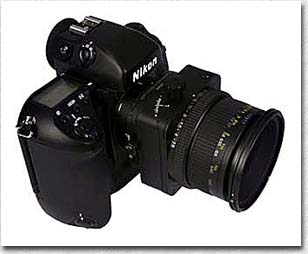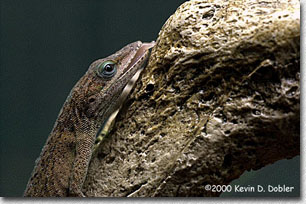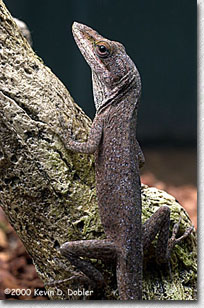|
|
 Camera Equipment Review... PC Micro-Nikkor 85mm f/2.8D
Text Copyright and Photography Copyright Kevin Dobler
Often times when the subject of tilt and shift lenses comes up, many nature photographers shrug them off with the thinking that they’re great for architectural photographers but not very functional for nature and wildlife photographers. We sometimes underestimate how effective tilt and shift lenses can be in enabling us to merge together what we think we see through the viewfinder and what the camera actually records on film. Our perception of what we see is influenced by many things including our emotions, and often times, what we are visualizing is not necessarily what will appear when the image is viewed on a light table. We may actually be visualizing something that is physically beyond the capabilities of the equipment we are using. However, there is hope! With the help of a tilt/shift lens, many of these limitations can be overcome to produce stunning images that are not possible with a conventional lens.
My first impression of the lens was WOW! This is a big lens for 85mm. It has a recessed front element like the 60f2.8 macro and a finish similar to that of the new 17-35/2.8. Its large aperture allows a lot of light into the viewfinder making it very easy to focus and with the push of a button you can stop the lens down to the desired f-stop without having to continually rotate the aperture ring. It is a manual lens and even though it couples to the electronics of the F5, the aperture still has to be set with the aperture ring on the lens barrel. The metering of both the F5 and the D1 worked great with the lens. The manual recommends that some amount of compensation be dialed in if the lens is tilted or shifted, something in the range of ±1 stop. It suggests metering the subject without any tilt or shift, set the exposure to the metered reading, compose with the needed tilting/shifting, and the make the final exposure compensation adjustments. Although this sounds slow and labor intensive, it can be done very quickly after just a little practice and familiarization with the lens.
Here’s a quick rundown of its technical specifications. The PC Micro-Nikkor 85mm f/2.8D is a manual focusing lens with an aperture range of f2.8 - f45. It’s 4.3 inches long, weighs 27.3 oz, has 6 elements in five groups and a filter size of 77mm. It has a tilt range of ±8.3°, a shift range of ±12.4mm, a minimum focusing distance of 1.3 ft, and a macro capability of 1:2 at its mfd (minimum focusing distance). The suggested list price is $1840 but can be found for less at your local camera store. PC Micro-Nikkor 85mm f/2.8D is a workhorse of a lens, able to handle a variety of tasks with ease. The quality of both the mechanics and the optics truly make this an outstanding lens. I captured a lot of images with this lens, both slide and digital. It consistently produced exceptional images that were sharp corner-to-corner. So if you’re looking to expand your photography toolbox and need a very functional lens that can do it all, this is the lens for you! |
|
|
 There are many lenses available today that we’d like to have in our camera bags, but the reality of space limitations and financial constraints push us to be practical about the gear we purchase and carry with us. I’m forever looking for ways to keep my equipment to a minimum and use lenses that are able to perform multiple tasks. The PC Micro-Nikkor 85mm f/2.8D is a lens that can handle a wide array of photographic chores including close-ups (macro), scenics, product shots and portraits. Its versatility to do all this, and do it so well, is what makes this lens really stand out.
There are many lenses available today that we’d like to have in our camera bags, but the reality of space limitations and financial constraints push us to be practical about the gear we purchase and carry with us. I’m forever looking for ways to keep my equipment to a minimum and use lenses that are able to perform multiple tasks. The PC Micro-Nikkor 85mm f/2.8D is a lens that can handle a wide array of photographic chores including close-ups (macro), scenics, product shots and portraits. Its versatility to do all this, and do it so well, is what makes this lens really stand out. Tilt and shift lenses are by design special application lenses. They encompass unique movements that allow the photographer to individually control both the depth of field and the perspective (convergence). Although these are generally used for two independently different purposes, tilt (depth of field) or shift (perspective), the lens’ internal mechanisms are designed to allow these two functions to work together simultaneously. Depth of field and image perspective involve two basic lens movements. The first is lens shifting which allows the lens to look up, down, or side to side. This corrects or minimizes the perspective distortion, better know as convergence. The second is tilting which is used to rotate the plane of focus such that it is no longer parallel to the film plane. This gives you control of depth of field which becomes very critical when working at minimum focusing distances with extension tubes.
Tilt and shift lenses are by design special application lenses. They encompass unique movements that allow the photographer to individually control both the depth of field and the perspective (convergence). Although these are generally used for two independently different purposes, tilt (depth of field) or shift (perspective), the lens’ internal mechanisms are designed to allow these two functions to work together simultaneously. Depth of field and image perspective involve two basic lens movements. The first is lens shifting which allows the lens to look up, down, or side to side. This corrects or minimizes the perspective distortion, better know as convergence. The second is tilting which is used to rotate the plane of focus such that it is no longer parallel to the film plane. This gives you control of depth of field which becomes very critical when working at minimum focusing distances with extension tubes.  I used extension tubes with this lens the majority of the time and found that for me, this is where the lens shines. With the tilt capability, even when photographing small critters like the Green Anole, the depth of field could be controlled to keep its body tack sharp throughout the shallow band of focus. This eliminates those visible bands of sharp/soft focus running though your images. The mechanics of the lens allows the barrel to be turned so that the tilt/shift axes can be rotated through an arc of 90°. This gives you the flexibility of composing with either the tilt or shift at any angle from horizontal to vertical, even though the tilt and shift axes are fixed 90° to one another.
I used extension tubes with this lens the majority of the time and found that for me, this is where the lens shines. With the tilt capability, even when photographing small critters like the Green Anole, the depth of field could be controlled to keep its body tack sharp throughout the shallow band of focus. This eliminates those visible bands of sharp/soft focus running though your images. The mechanics of the lens allows the barrel to be turned so that the tilt/shift axes can be rotated through an arc of 90°. This gives you the flexibility of composing with either the tilt or shift at any angle from horizontal to vertical, even though the tilt and shift axes are fixed 90° to one another.